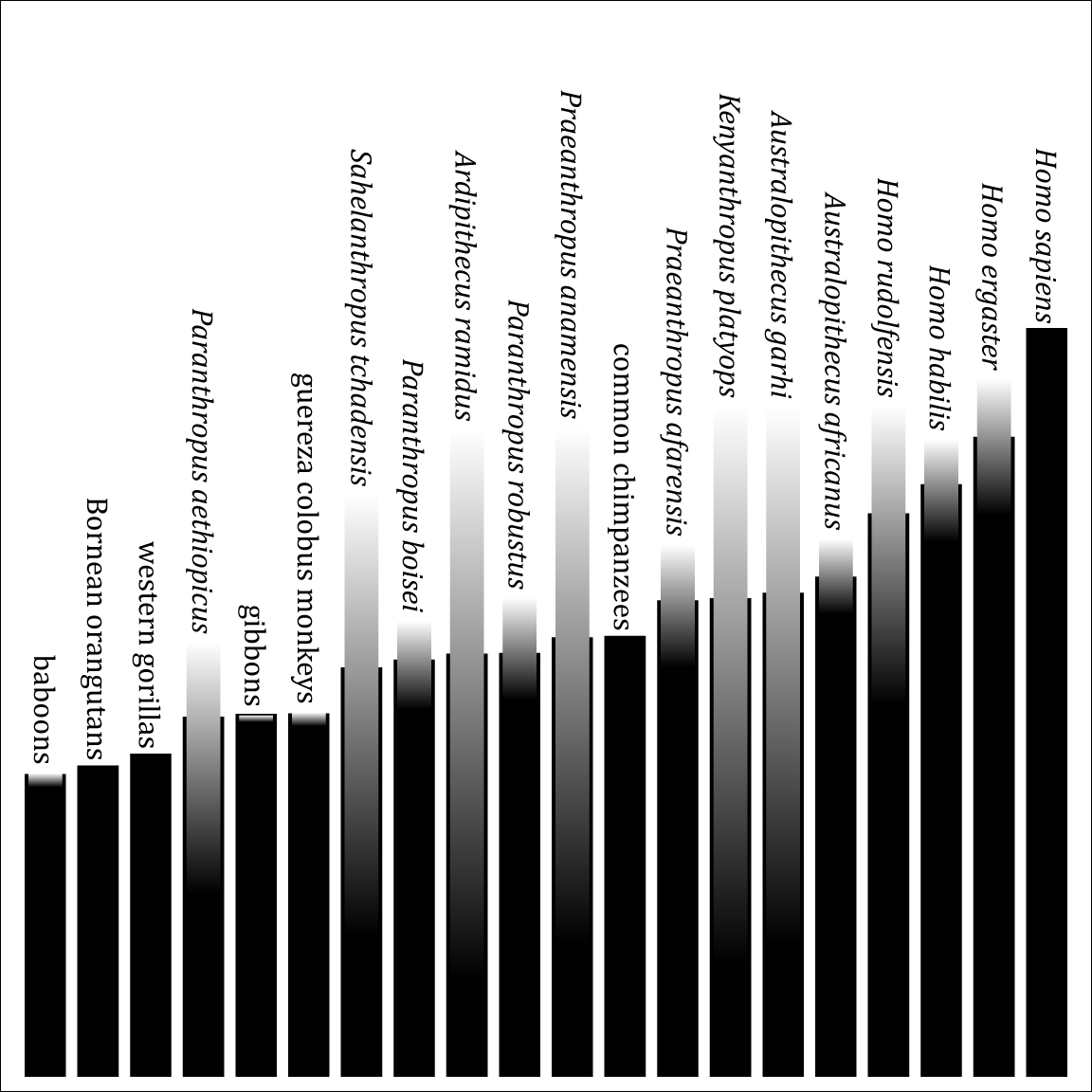This black lines indicate the probable distance, as inferred from the phylogeny. The gradients show the actual range of uncertainty. (They'd also show polymorphism, but this matrix has none.) Ordering is according to probable distance—using the mean of the range of uncertainty yields slightly different results.
As in the soft-tissue diagram, chimpanzees are closer to humans than any other living primates are. But, oddly, gibbons and colobus monkeys are closer to humans than gorillas and orangutans! My guess is that this is because gorillas and orangutans are more derived from the ancestral catarrhine state than gibbons or colobus monkeys. (This probably also explains why the Paranthropus species, a.k.a. "robust australopithecines", are further than chimpanzees, although it is strange that the earliest one, P. aethiopicus, is furthest.)
As in the soft-tissue diagram, chimpanzees are closer to humans than any other living primates are. But, oddly, gibbons and colobus monkeys are closer to humans than gorillas and orangutans! My guess is that this is because gorillas and orangutans are more derived from the ancestral catarrhine state than gibbons or colobus monkeys. (This probably also explains why the Paranthropus species, a.k.a. "robust australopithecines", are further than chimpanzees, although it is strange that the earliest one, P. aethiopicus, is furthest.)
To the right of chimpanzees is a very unsurprising pattern: "gracile australopithecines", then basal Homo species, then the large-brained Homo ergaster, and finally the huge-brained Homo sapiens.
You can also see how well-known the fossil crania are, ranging from the very well-known Australopithecus africanus to the crushed skull of Kenyanthropus platyops. Note that Ardipithecus ramidus is much better known now than when this study was done.
Again a disclaimer: this is not an objective measure of morphological similarity (there is no such thing), and it is definitely not a phylogenetic analysis (even if the data is taken from one).
References
- Strait & Grine (2004). Inferring hominoid and early hominid phylogeny using craniodental characters: the role of fossil taxa. Journal of Human Evolution 47:399–452. doi:10.1016/j.jhevol.2004.08.008

*blink* No polymorphism? I'll have to have a look at their selection of characters, because things like canine length differ a lot within Homo sapiens, as does – independently – the degree to which the canines are caniniform vs. intermediate between incisi- and premolariform.
ReplyDeleteI should say that the matrix does not record multiple states for any character. It may code some polymorphisms as their own state. I don't have the paper in front of me, but I need to check this. (And, if it is the case, I may need to make a modified version.)
DeleteYup, they do record polymorphisms as separate states. E.g.:
DeleteSG46 Direction of mental foramen opening:
0 - Anterior
1 - Variable
2 - Lateral
3 - Posterior
Not a huge fan of that, I must say.
On another note, I got some fascinating results when plugging in other taxa as the focus instead of Homo sapiens. I think I may write that up later, but for now I'll just say:
ReplyDelete- Paranthropus is more derived than Homo, at least from some "viewpoints".
- Kenyanthropus rudolfensis
- Ardipithecus anamensis
Wrote it up: Using Morphological Distance to Determine Genera.
Delete